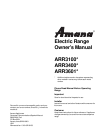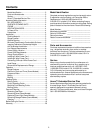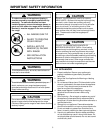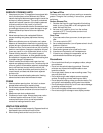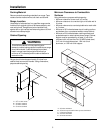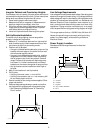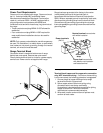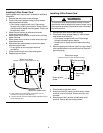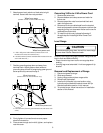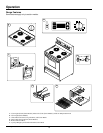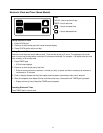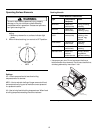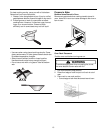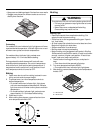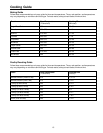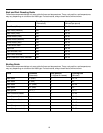
4
SURFACE COOKING UNITS
1. Use proper pan size. This appliance is equipped with
one or more surface units of different size. Select
utensils having flat bottoms large enough to cover the
surface unit heating element. The use of undersized
utensils will expose a portion of the heating element
to direct contact and may result in ignition of
clothing. Use of oversized utensils concentrates heat
on cooking surface and can cause damage to range.
Proper relationship of utensil to burner improves
efficiency.
2. Never leave surface units unattended. Boilover
causes smoking and greasy spillovers that may
ignite.
3. Make sure reflector pans or drip bowls are in place.
Absence of these pans or bowls during cooking may
subject wiring or components underneath to damage.
4. Protective liners. Do not use aluminum foil to line drip
bowls or oven bottoms. Improper installation of these
liners may result in a risk of electrical shock, or fire.
5. Glazed cooking utensils—Only certain types of
glass, ceramic, earthware, or other glazed utensils
are suitable for rangetop service without breaking due
to sudden change in temperature.
6. Utensil handles should be turned inward and not
extend over adjacent surface units. To reduce the risk
of burns, ignition of flammable materials, and spillage
due to unintentional contact with the utensil, the
handle of a utensil should be positioned so that it is
turned inward, and does not extend over adjacent
surface units.
7. Do not soak removable heating elements. Heating
elements should never be immersed in water.
OVENS
1. Use care when opening door. Let hot air or steam
escape before removing or replacing food.
2. Do not heat unopened food containers. Build-up of
pressure may cause container to burst and result in
injury.
3. Keep oven vent ducts unobstructed.
4. Placement of oven racks. Always place oven racks
in desired location while oven is cool. If rack is
removed while oven is hot, do not let potholder
contact hot heating element in oven.
VENTILATION HOODS
1. Clean ventilation hoods frequently. Grease should not
be allowed to accumulate on hood or filter.
2. When flaming foods under hood, turn fan on.
In Case of Fire
Fires can occur as a result of over cooking or excessive
grease. Though a fire is unlikely, if one occurs, proceed
as follows:
Surface Element Fire
1. Smother the fire with a nonflammable lid or baking
soda, or use a Class ABC or BC extinguisher. Not
water. Not salt. Not flour.
2. As soon as it is safe to do so, turn the surface
controls to
OFF
. Turn off power at main circuit
breaker or fuse box.
Oven Fires
1. If you see smoke from your oven, do not open oven
door.
2. Turn oven control to
OFF
.
3. As an added precaution, turn off power at main circuit
breaker or fuse box.
4. Turn on vent to remove smoke.
5. Allow food or grease to burn itself out in oven.
6. If smoke and fire persist, call fire department.
7. If there is any damage to components, call an
authorized servicer before using range.
Precautions
• Do not cook food directly on rangetop surface, always
use cookware.
• Do not mix household cleaning products. Chemical
mixtures may interact with objectionable or even
hazardous results.
• Do not put plastic items on warm cooking areas. They
may melt and stick.
• Do not slide rough metal objects across rangetop
surface. Scratching or metal marking can result.
• Do not leave fat heating unless you remain nearby. Fat
can ignite if overheated by spilling onto hot surfaces.
• Do not allow pots to boil dry as this can cause damage
to cooking surface and pan.
• Do not use rangetop surface as a cutting board.
• Do not use range for storage or as a display counter.



